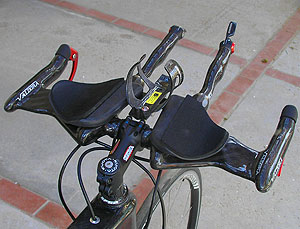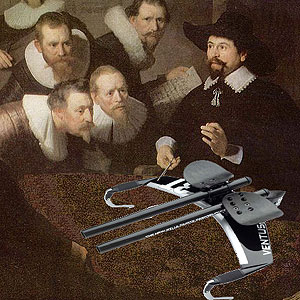Felt’s Devox aerobar
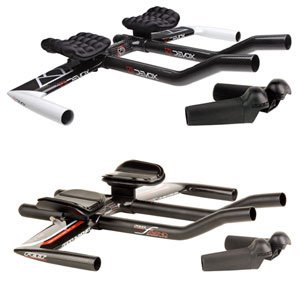
Can a company have cajones? The U.S. Supreme Court, based on recent precedents vesting corporations with rights enumerated in the Constitution would, based on this logic, would be compelled to say, "Yes." And who am I to disagree with the Supreme Court?
In order to appreciate Felt's cajones, first realize that Felt is not Trek. The latter is a corporation that sells in the neighborhood of $700 million of product in a year. How much does Felt sell? I don't know with precision, but, it would take many multiples of Felt to equal a Trek.
Yet, Felt does much or most of what Trek does: It sells a full line of bikes, from entry level to top end, from road to MTB, kids bikes to cruisers, up and down and side to side. It also sponsors a pro tour team, and not just any pro tour team, rather, one of the world's best, and that's not cheap.
That should be enough for an upstart brand. Here's where I think Felt goes further: It's trying to be a full-fledged component brand, and executed this in the context of a niche sport like triathlon, where the design requirements are heavy and expensive. The easy thing would be to just partner with a handlebar company, and to have that company not only spec bars for your bikes, but to help pay the freight for expensive ventures: like pro tour teams and top end triathletes.
In designing its own aerobar, Felt not only incurred formidable engineering costs and barriers, it did so knowing that it's at cross purposes with itself in its marketing efforts, to wit, Trek's sponsorship of Radio Shack means also a Bontrager sponsorship (including Bontrager's aerobars). Felt's partnering with Garmin Transitions doesn't mean a Devox sponsorship, and that's a hurdle Felt must overcome.
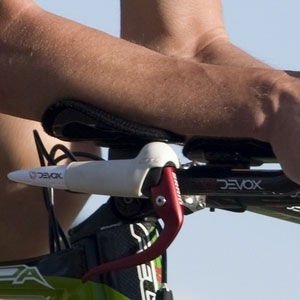
Felt can't put its own bars on its own Garmin-ridden bikes. 3T sponsors that team. Wouldn't it just have been easier, then, to form a partnership with 3T that included OE spec on Felt bikes? Seems that this would be the path of least resistance.
But Felt powered its way to its own aerobar, and it's branded Devox. Now, truth be told, if you'd have given me the choice of 3T or Devox on my own timed race bike, I'd have taken 3T. In fact, I do ride 3T.
But I was given the opportunity to ride the Tour of California Time Trial aboard a Cannondale Slice 2, and, when I did the math on what I'd need to ride in order to capture and reproduce my personal fit coordinates on the Slice—lo!—a Devox aerobar proved to be just the geometric ticket.
So, what about that bar? Well, I'll tell you about it. Felt did a lot of things right.
Self conformity
Aerobars need to "agree with themselves." By that I mean that the extension terminus needs to sit along the plane of the armrest, and that the pursuit contact point needs to match the armrest in all three planes. With this bar, all that is accomplished, with this proviso: The pursuit bar as tested was a bit wide, and this is addressed further below.
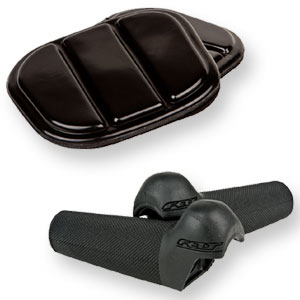
Just know that Felt's F-bend might not necessarily provide you the elevation congruity you want, if you don't cut the extension below the final bend, and if you couple that with leaving the armrest in its lowest, unstacked, configuration. Felt's F-bend allows you a more upturned hand-hold contact point, or a more gradual, flatter contact point, and you get the sharper upturn by cutting the extension just prior to the final "knuckle." But if you don't cut just prior to the knuckle, you're holding higher up the bar, and this might require a modest riser between the armrest and the pursuit bar.
This is no problem, but, if what you need is an exceptionally low profile aerobar, this means no riser between the armrest and the pursuit bar. But this probably also means cutting the final upturn off the extension, or, using an extension that mates well with a low profile aerobar, like the Wrist Relief.
In its native config, as discussed, the Devox is a low-profile bar, and the Devox needs not only to conform internally with itself, it needs to conform to the bike on which it's placed. Its mating with the higher end Felt bikes means that a low-profile bar is sitting aboard a low-profile, long and low, bike. Mind, the Felts are only moderately long and low. But Felt's 2010 Bayonet is a bit lower in profile to the 2009 and previous models. What will Felt's 2011 bikes look like geometrically? I don't yet know, and won't for another month.
But the Devox is just as likely—maybe more likely—to be a good match on a moderate-geometry bike. In other words, there's an irony here: Felt's Devox bar might be a better match for the greater number of people when placed on bikes other than those made by Felt. I ride a Devox on a Cannondale Slice. Specialized, Scott, and certain other brands might find that the Devox solves problems for athletes who need a lower position than the OE bars on those bikes grant.
Ergonomics
Felt offers a couple of armrest uppers, the most popular of which seems to be the gel pad that Felt also offers as a replacement pad. A criticism I've heard is that the pad would or should get slick when you sweat. But that was not my experience. I found the gel pad quite comfortable during rides exceeding 2 hours.
If you look at the profile of the pursuit bar, the straight, not upturned, protrusion might put some folks off—many want a slight upturn against which you can brace your weight during braking. But the molded rubber grip has a knob that works quite nicely in place of an upturn, and this give the bar both the aerodynamic benefit of a level terminus with the bracing mechanism needed during braking.
This is what Felt calls its Tri Tip Grip, and it's a $20 item sold as an accessory that seems to me an attractive adjunct to other level pursuit termini, such as what's found on 3T's Brezza.
Spatial relationships
I've grown more and more averse to two trends in pursuit bars: a forward protrusion of the pursuit contact points, and a decrease in elevation (a downward slope) of such contact points. Each tendency causes more weight to be cantilevered over the front of the bike. Felt's Devox resists both these trends.
The bar I tested had a width of 42cm. My one complaint about this Devox to its makers is that I did not feel I needed that width for control of the bike when braking and handling, and any more width than necessary seems to me to add unnecessary drag. I was informed that newer iterations are made in a 39cm width, and I don't see the need for anything wider.
Simplicity in engineering
The extensions tightened based on a simple pinch mechanism instead of a collet. Sure, lots of companies use pinch mechanisms. But who uses that sort of tightening scheme on a bar where the extensions emanate from the center of the pursuit bar? Few. Easton and HED each make, or have made, clip-ons with a "plug" just in front of the pursuit bar and this plug used or uses a pinch bolt.
Felt's way of making this work seems more elegant, with the pinch bolt hidden inside the aerobar's exterior works. This style—burying the extensions into the pursuit bar—seems to me the desired place for which extensions should emanate, if you want to present the smallest frontal profile to the wind.
It also allows the armrests to sit in a low-profile fashion, barely above the deck of the bike.
Part of this smaller front area is the use of a 26.2mm clamp diameter. That's a small diameter for so much weight cantilevered so far out from the clamp. But Felt uses friction paste on the clamp surface, and I had no problem tightening the bar without excessive torque. In fact, as some readers know, I took a header on this bike, with this bar, as I rode over a depressed manhole in the ToC TT. If this bar was ever going to slip down, it was during that digger. In fact, the bike, the bar, the wheels, everything was untouched and unharmed during the fall. Except, that is, for a few bones.
Weight and Pricing
There are two pursuit bars, two sets of armrests, and two sets of extensions, that make up the Devox line. The difference between each is: one is carbon and lighter; the other is aluminum and heavier. You can mix and match them all, and you can slide in a non-Felt extension if it's 22.2mm in O.D., as they all are.
The two Devox pursuit bars differ in weight, of course. The aluminum pursuit bar weighs about 400g, the carbon bar 300g. If you pick up each bar, the weight difference is obvious and strident, especially when the carbon pursuit bar has carbon armrests mounted, versus the all-aluminum set.
What's the weight difference in the two armrest clamp and trough systems? The carbon set weighs less than half that of the aluminum armrest complexes, 29g versus 62g. That's times 2. So, the armrest weight difference makes up about two-thirds the weight difference in the pursuit bar.
Extensions are about 75g heavier in aluminum than in carbon, so, that's 150g for the pair. That's the biggest difference. But remember that the extensions are likely to be cut, so, that difference between carbon and aluminum might be closer to 100g.
Carbon pursuit bars + carbon armrests + carbon extensions make up one complex. That construct costs $900. Keeping the carbon pursuit bar, but subbing in aluminum extensions and armrests drops the price to $500. Aluminum all the way around drops the price to $380.
I think the middle ground—carbon pursuit bar and alumimum elsewhere—seems to me to be the biggest bang for buck.


